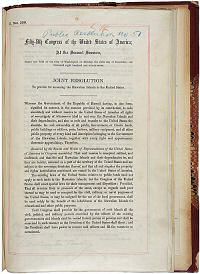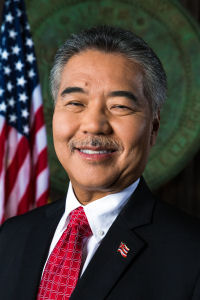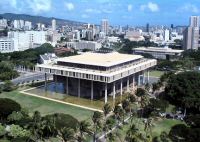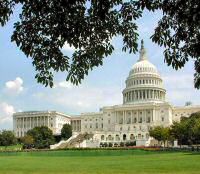 |
1898 JOINT RESOLUTION to
Provide for Annexing the Hawaiian
Islands to the United States
National Archives and
Records Administration
[ Transcript | First Page PDF ] |
STATEHOOD:Hawaii was once ruled by kings and much of its history concerns the
relationships of the rulers with the outside world of missionaries, traders, and businessmen. It could
be argued that the road to statehood began in 1835 when the first commercial production of sugar cane
began.
King Kalakaua, called the Merry Monarch, came to the throne in 1874. During his reign, sugar
cane became a dominant industry. Most of the sugar cane crop was shipped to the United States, especially
San Francisco. This was good for American businessmen, but...
American businessmen were nervous about nations in Europe and their eagerness to add Hawaii
to their empires. They looked to the United States government for help and security and in 1875, a
treaty of reciprocity was negotiated with
the Kingdom of Hawaii, leading the way to an influx of American investment.
In 1891, King Kalakaua died. His sister, Liliuokalani, assumed the throne. Queen Liliuokalani
tried to create a new constitution that would increase her power and change the balance of political
power in the kingdom. Business interests were not happy with the queen's direction and a revolt forced
Liliuokalani from her position in 1893. The leaders of the revolt formed the Republic of Hawaii in 1894.
American business executives controlled the government of the new republic and wanted the islands to
become a territory of the United States. In 1898, they succeeded in getting the United States to
annex Hawaii. The islands
became a U.S. territory on July 7, 1898 when President William McKinley signed the
Newlands Resolution.
In the early 1900's U.S. Navy started to build a base at Pearl Harbor. The Army established
camps on Oahu. In 1934, President Franklin D. Roosevelt became the first U.S. President to visit Hawaii.
On Dec. 7, 1941, planes of the Japanese navy attacked Pearl Harbor and airfields on Oahu. The United
States suffered heavy losses in lives, ships, and aircraft and entered into World War II in response.
The first bill for Hawaiian statehood was introduced by Jonah Kuhio Kalanianaole, Hawaii's
Territorial Delegate to Congress, in 1919. Many more statehood bills followed, but most were not even
voted on. In 1950, Hawaii adopted a constitution to go into effect when the territory became a state.
Finally, in March 1959, Congress approved legislation to admit Hawaii as a state. President Dwight D.
Eisenhower signed the bill on March 18. In June, the people of Hawaii voted almost 17 to 1 for statehood
and Hawaii became the 50th state to join the Union on August 21, 1959. |
| |
 |
King Kamehamena III introduced the first
Hawaii Constitution
Courtesy of Henry Soszynski |
STATE CONSTITUTION:A constitution sets out the rules by which we play the game
of government. Like the rules for any other game, it limits the moves available to players. It describes how
the various players interact with each other, and who has more power in various situations.
PREAMBLE: We, the people of Hawaii, grateful for Divine Guidance, and mindful
of our Hawaiian heritage and uniqueness as an island State, dedicate our efforts to fulfill the
philosophy decreed by the Hawaii State motto, "Ua mau ke ea o ka aina i ka pono."
We reserve the right to control our destiny, to nurture the integrity of our people and culture, and to
preserve the quality of life that we desire.
We reaffirm our belief in a government of the people, by the people and for the people, and with an
understanding and compassionate heart toward all the peoples of the earth, do hereby ordain and
establish this constitution for the State of Hawaii. [Am Const Con 1978 and election Nov 7, 1978]
[ HAWAII CONSTITUTION ] |
| |
|
STATE MOTTO:This motto is attributed to King Kamehameha III who presided over the Kingdom
of Hawaii from 1825 until his death in 1854. This son of Kamehameha the Great was born Kauikeaouli at
Keauhou, North Kona and assumed the position of Kamehameha III when his older brother, Kamehameha II,
died in England in 1824.
Kamehameha III, educated as a traditional Hawaiian chief and in the ways of Westerners by Protestant
missionaries, presided over several important occurrences in the kingdom. He began to modernize the laws
that had governed the islands for over a thousand years he introduced the first Hawaii Constitution in
1840. He also presided over the division of lands between the king and the chiefs in 1848. Prior to
this time, all land belonged to the king.
In the 1840's the French and British were very interested in expanding their empires and were
anxious to lay claim to Hawaii. On February 10, 1843, Lord Paulet of the Royal Navy sailed into Honolulu
harbor and captured the town. Intense negotiations followed and eventually, Admiral Richard D. Thomas
disapproved Lord's Paulet's actions and on July 31, 1843, the Hawaiian flag was again raised over Hawaii.
It is on this day that Kamehameha III is said to have proclaimed "Ua mau ke ea o ka aina i ka pono,"
translated, "The life of the land is perpetuated in righteousness."
The Hawaiian motto is declared in Article XV, Section 5. of the Hawaii Constitution. "The motto
of the State shall be, 'Ua mau ke ea o ka aina i ka pono'" and in the Hawaii Revised Statutes. The motto
also appears on the State seal of Hawaii. |
| |
|
STATE GOVERNMENT:As in the case of the federal government, Hawaii's state government is
organized into three branches - executive, legislative, and judicial. The state government is a product of
three documents: the United States Constitution, the Hawaii State Constitution, and laws of the state.
In the executive branch, the Governor is the head of the State of Hawaii and is responsible
for the execution of laws and the supervision of the
executive departments. He
(or she) sees that all the laws of the state are executed and governs most state agencies. The Governor
establishes the goals of the state and outlines ways to reach those goals.
The major task of the Legislature is to create and maintain laws. The members of the
Legislature also conduct investigations on various matters, consider requests or petitions from the
public, confirm certain officers appointed by the governor, participate in amending the Hawaii
Constitution, and exercise authority to punish people for certain offenses against the Legislature or
its members.
Hawaii's Judicial system, under the administration of a chief justice, operates on
two levels. One level, called the appellate level, consists of the Supreme Court of Appeals. The
Supreme Court is the highest court in the state and hears appeals from other courts. It may choose
to review cases or assign them to the Intermediate Court of Appeals. The other level, the trial level,
consists of the Circuit Courts and the District Courts. This level presides over civil and criminal
cases and is where jury trials are held.
In general, the state government provides those services that are statewide in nature, such
as education, transportation networks, public health and welfare, and public works, and which require a
uniformity of standards and regulations.
[ THE EXECUTIVE BRANCH ]
[ ABOUT THE LEGISLATURE ]
[ JUDICIAL SYSTEM ]
[ GREAT SEAL OF HAWAII ]
[ HAWAII STATE FLAG ] |
| |
 |
Hawaii Governor David Y. Ige
Courtesy of the State of Hawaii |
GOVERNOR:David Yutaka Ige (Democrat)
FIRST LADY:Dawn Ige
[ GOVERNOR'S PAGE ]
[ FORMER STATE GOVERNORS ]
[ WASHINGTON PLACE ]
[ SITES TO SEE ]
[ HONOLULU STAR-BULLETIN STORY 1 ]
[ HONOLULU STAR-BULLETIN STORY 2 ]
[ WALKING TOUR ]
|
| |

Hawaii State Capitol Building
Courtesy of the State of Hawaii |
HAWAII CAPITOL BUILDING:
Location:Honolulu
Date Opened:March 15, 1969
- The two legislative chambers are cone-shaped, like volcanoes, symbolizing the geological origin of the Hawaiian Islands, which rose upward from the sea floor over eons.
- The columns are representative of the graceful palm trees of Hawaii, so important to the early Hawaiians as a source of food and building material.
- The mosaic design in the center of the rotunda, "Aquarius," was created by island artist Tadashi Sato and shows the changing colors and patterns of Hawaii's seas.
- The chandeliers in the legislative chambers were designed by artist Otto Piene. "Moon, " in the Senate is made of polished aluminum and chambered nautilus shells; "Sun, " in the House of Representatives, of gold-plated copper and brass.
- The tapestries hanging in the chambers, composed of warm earth colors in the House and cool sea and sky colors in the Senate were designed, by Ruthadell Anderson.
- A vast pool of water surrounding the State Capitol, symbolizes Hawaii as the only island-state in the nation.
[ ABOUT ]
[ SLIDE SHOW ]
[ TOURS ] |
| |
|
STATE REPRESENTATION:The Hawaii Legislature is composed of two bodies
like the United States Congress, the House of Representatives and the Senate. The Legislature is referred to as
a bicameral body because it is made up of two houses. The Latin roots of the word bicameral, "bi" and "cameral,"
mean two chambers or rooms. Members of the Senate are called Senators and members of the House of
Representatives are called Representatives.
[ LEGISLATIVE BRANCH ] |
| STATE REPRESENTATIVES:Representatives in Hawaii each represent
people in a specific area of the state. These areas are called house districts. There are currently 51 men
and women representing 51 house districts in the Hawaii House of Representatives. 15 representatives are
Republicans and 36 are Democrats. Each representative serves for a period of two years in the House of
Representatives, after which he or she must run for re-election.
[ STATE REPRESENTATIVES ] |
STATE SENATORS:Senators in Hawaii each represent people
in a specific area of the state. These areas are called senate districts. There are currently 25 men and
women representing 25 senate districts in the Hawaii Senate. 5 senators are Republicans and 20 are
Democrats. Each senator serves for a period of four years in the Senate, after which he or she must run for
re-election.
[ STATE SENATORS ] |
|
| |
|
LEGISLATIVE PROCESS:The legislative branch of government is responsible for making and
maintaining laws within their jurisdiction. United States representatives and senators, federal legislators,
are responsible for laws at the national level and state legislators are responsible for laws at the state
level. A law begins as an idea that is introduced in the Hawaii Legislature as a bill by one or more
legislators. The bill then goes through the legislative process to become a law. During this process the bill
may be changed. Not all bills become law.
[ CITIZEN'S GUIDE ]
[ HOW A HOUSE BILL BECOMES LAW ] (PDF)
[ ABBREVIATIONS, ACRONYMS, TERMINOLOGY ] |
| |
| CURRENT LEGISLATION:When the legislature is meeting, it is said
to be "in session." The Hawaii Legislature meets each year at 10 a.m. on the third Wednesday of January for a
regular session of up to 60 days. Special sessions, limited to 30 days, may be held by the Legislature's
presiding officers or the governor. The following link will allow you to look at bills that are currently going
through the legislative process.
[ CURRENT LEGISLATION ] |
| |
| STATUTES:The following link will allow you to look at Hawaii's current laws.
[ HAWAII REVISED STATUTES ] |
| |
| COUNTIES:The United States Constitution does not define local government.
Instead, this function is left up to the states.
Counties are a local unit of government within a state. All but two of the states are divided into
counties. Alaska is divided into boroughs and census districts and Louisiana is divided into parishes.
Governing responsibilities in boroughs and parishes are similar to those of counties.
Traditionally, counties performed tasks mandated by the state, such as property assessment, property and vital
statistic record keeping, maintenance of rural roads, administration of local election and judicial functions,
and support of the poor. Today, counties may be responsible for these functions, more or less, but the
responsibilities of county governments vary from state to state.
The responsibilities of the Hawaii county governments include police and fire protection, refuse
collection, maintenance of streets and parks, and other functions traditionally assigned to cities or towns
on the mainland.
[ ABOUT COUNTY GOVERNMENT ]
[ ASSOCIATION OF U.S. COUNTIES ]
[ US CENSUS BUREAU ]
[ STATE MAPS ]
| COUNTY TRIVIA:
- Hawaii's eight main islands are divided into five counties
- Hawaii County is the largest county at 4,028 square miles and includes the island of Hawaii, the big island
- Kalawao County is the smallest county, only 13 square miles in area. It's located on the island of Molokai
- Honolulu City and County, located on the island of Oahu, is the most populated with 876,156 people (2000)
- The least populated county is Kalawao County, with 147 people (2000)
KALAWAO COUNTY IS UNIQUE:
- Kalawao County is located on the north coast of the island of Molokai, on the Kalaupapa Peninsula
- The county of Kalawao consists of the areas of Molokai known as Kalaupapa, Kalawao, and Waikolu
- Kalawao County is the smallest county in Hawaii, both in land area and population
- It is the smallest county, in land area, in the United States
- It has the second smallest county population in the United States behind Loving County in Texas
- Kalawao County is the only county in the United States where it is illegal to enter without a permit or unless a personal guest of a resident
|
 |
| Kalaupapa Peninsula, Molokai |
KALAWAO COUNTY NOTES:Kalawao County holds a unique place in Hawaiian
history. On January 3, 1865, King Kamehameha V signed "An act to Prevent the Spread of Leprosy." This law
authorized the setting apart of land specifically to isolate and treat leprosy (Hansen's Disease) patients.
Kalawao, on the Kalaupapa Peninsula, was set aside for that purpose and in 1866, the first patients took up
residence at the Kalaupapa Settlement.
In 1969, Hawaii's isolation laws were abolished and in 1980 President Jimmy Carter signed the law
that established Kalaupapa National Historical Park on the peninsula. Kalawao County is unique among the
Hawaiian counties. It does not function as a governing unit like the others and, in fact, is under the
jurisdiction of the Hawaii Department of Health. A glance at the
Hawaii
Revised Statutes will give you an idea about how it differs. Most county law does not apply to Kalawao.
Today, former Hansen's Disease patients at Kalaupapa, who still require medical attention due to the
effects of the disease, are no longer required to live there. Those who do live there have chosen to live
there. Public access to this community is very limited because of regulations safeguarding privacy.
[ KALAUPAPA SETTLEMENT HISTORY ]
[ FATHER DAMIEN ]
[ MOTHER MARIANNE COPE / SISTERS OF ST. FRANCIS ] |
|
| |
 |
United States Capitol Building
Washington, DC |
U.S. CONGRESSIONAL DELEGATION:
The legislative branch of the United States government makes laws for our nation and raises and distributes
money to run the United States government. The most evident part of the legislative branch is the United
States Congress. Congress is divided into two parts, called houses. The two parts are the Senate and the House
of Representatives. Congress is referred to as a bicameral body because it is
made up of two houses. The Latin roots of the word bicameral, "bi" and "cameral," mean two chambers or rooms.
Members of the Senate are called Senators and members of the House of Representatives are called Representatives.
Senators and representatives serving in these two bodies are sometimes referred to as congressmen, or women, and
sometimes as legislators because their business is to legislate or make laws. The role of the legislative
branch is defined in the United States Constitution.
[ THE UNITED STATES CONSTITUTION ]
Each state elects people to represent them in the United States Congress in Washington, DC. The citizens of each
state elect two senators to represent them in the Senate. They also elect representatives to represent them in
the House of Representatives. The number of representatives each state sends to the House of Representatives
is not a specific number like the Senate, but is based on the population of the state. The people, that are
elected to represent the state's citizens in the United States Congress, are referred to as the congressional
delegation.
There are 100 senators in the U.S. Senate. Each is elected to a term, in the Senate, of six years. There are 435
representatives in the U.S. House of Representatives. Each is elected to a term, in the "House," of two
years.
The citizens of Hawaii elect two people, like every other state, to represent them in the Senate
and two people, based on Hawaii's population, to represent them in the House of Representatives.
| U.S. House of Representatives (2): |
|
|
| |
|
broken links to us. We really appreciate it. |
Source: eHawaiiGov, (http://www.state.hi.us/), April 14, 2004
Source: Hawaii Legislature, (http://www.capitol.hawaii.gov/), April 14, 2004
Source: National Park Service, (http://www.nps.gov), April 15, 2004
Source: National Association of Counties, (http://www.naco.org), April 14, 2004
Source: National Governor's Association, (http://www.nga.org), April 14, 2004 |

 |
|
|
[ HOME
|| INTRO
|| SYMBOLS
|| ALMANAC
|| ECONOMY
|| GEOGRAPHY
|| STATE MAPS
|| PEOPLE
|| GOVERNMENT
]
[ FORUM
|| NEWS
|| COOL SCHOOLS
|| STATE QUIZ
|| BOOK STORE
|| MARKETPLACE
|| STATE LINKS
]
|| GUESTBOOK
|| CONTACT US
|| PRIVACY STATEMENT
] |
Site designed exclusively for NETSTATE.COM by NSTATE

NETSTATE.COM is a Trademark of NSTATE, LLC.
Copyright © 2003- by NSTATE, LLC. All rights reserved.
No copyright is claimed on non-original or licensed material.
Support NETSTATE
Top |
|



